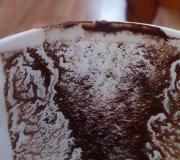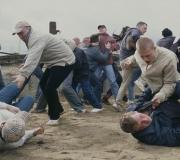Savior Leonardo da Vinci. Official: “Savior of the World” is the most expensive painting on the planet. The image of Jesus Christ was sold for half a billion dollars.
He has already been nicknamed the Male Mona Lisa, and he is what Christie's declares to be "the biggest discovery of the 21st century."
A New York auction house this morning unveiled its previously secret and "most exciting acquisition to date": Salvator Mundi (Salvator Mundi), a previously lost masterpiece by Leonardo da Vinci that is believed to be the artist's last painting. "Salvator Mundi is the holy grail of artistic discovery," said Alex Rotter, Christie's co-chairman.

The painting is one of a few - there are only about 15 Da Vinci paintings known to exist. (To understand the importance of this event in the art world, imagine that the last time Da Vinci was discovered was 1909.)
It was hidden behind Christie's opaque sliding glass doors until it was announced - an invitation to a press conference "You are invited to the first ever openingan unprecedented masterpiece" (“You are invited to a first-ever unveiling of AN UNPRECEDENTED MASTERPIECE”)was written under a giant question mark in a gilded frame.The painting originally hung in the collection of King Charles I and depicted the blessed Jesus Christ, dressed in azure robes and holding an orb, one arm extended upward; The Mona Lisa was painted around the same time.
Salvator Mundi first appeared in 2005 (it sold at Sotheby's for £45 in 1958) and was presented at the National Gallery in London in 2011; the director of the National Gallery called its arrival "an event greater than the discovery of a new planet."
Immediately after today's press conference, the film will tour the world, appearing in Hong Kong, San Francisco and London, before returning to New York, where it will be exhibitedfor auction.

Of the 15 Da Vinci paintings currently known, Salvator Mundi is the only one in private hands. It will be sold at Christie's auction, and the estimated price is $100 million. “Who will buy it?” - said Guzer. “Who knows. But there would be no Louvre without the Mona Lisa, and there would probably be no Paris without the Louvre; whoever buys it will perpetuate his name, his collection, most likely, and probably his city.”
“Savior of the World” (Salvator Mundi) dates back to 1500: it is believed that this last work of the artist - a portrait image of the Savior holding a crystal ball with his left hand and clasping his fingers in blessing with his right - was lost for a long time.
“For many years, until 2005, the painting was considered lost,” says Christie’s press release. “The first documentary mention of it is found in the inventory of the collection of King Charles I (1600-1649). It is believed that it decorated the chambers the king's wife, Henrietta Maria of France, at the royal palace at Greenwich, and was then inherited by Charles II.'' The next time, according to the auction house's description, the painting was mentioned was in 1763, when it was put up for auction by Herbert Sheffield, the illegitimate son of the Duke of Buckingham.

The queue for Leonardo da Vinci's painting "Salvator Mundi" before the auction in New York, November 2017
Julie Jacobson/APSalvator Mundi then resurfaces in 1900, when it was acquired by Charles Robinson, but as the work of Bernardino Luini, one of Leonardo da Vinci's followers. “As a result of this, Salvator Mundi joins the collection of the Cook family, located in Richmond’s Doughty House,” continues Christie’s. “In 1958, when information about the royal provenance and authorship of Leonardo was lost, the painting went under the hammer during the auction Sotheby's for just £45, after which it is forgotten again for almost half a century."
In 2013, the painting was purchased for $127.5 million by Russian billionaire Dmitry with the help of Swiss dealer Yves Buvier.
He, in turn, bought it for $80 million at a private auction at Sotheby's auction house from three art dealers. One of them, as he claims, discovered the painting at a real estate auction eight years earlier and bought it for $10 million (then experts still it was assumed that this was the work of an artist from the school of Leonardo).
Now “Salvator Mundi” has been sold to an unknown buyer for an amount 45 times higher than what the unnamed art dealer paid in the early 2000s, while the original price of the painting, which Christie’s declared, was already $100 million.
Telephone bidding with six unknown buyers lasted 20 minutes. At the end, the audience burst into applause. Auction host Jusi Paikkanen said: “This is the zenith of my career as an auctioneer. There will never be another painting that I sell for more than this one tonight.”
Salvator Mundi actually broke the previous record that an Old Master painting had ever held. Previously, the most expensive work in this category was considered to be “The Massacre of the Innocents” by Rubens, which went under the hammer in 2002 for $76.7 million at Sotheby’s.
Crime and Punishment
Even the dubious circumstances associated with this painting and its previous owner Dmitry Rybolovlev and art dealer Yves Buvier did not affect the price. In 2013, when three dealers sold a painting through Sotheby's for $80 million, the Swiss sold it to a Russian businessman for $47.5 million more just a few days later. The sellers of the painting wrote to Sotheby's asking if they knew that the painting already had another buyer? Perhaps the auction representatives even showed Rybolovlev the work in advance?
Art dealers threatened to sue if it turned out that they were victims of fraud, and they were paid less for the painting than it was actually worth.
Representatives of the auction house took action, being the first to send this appeal to the Manhattan District Court to block the lawsuit: they said that they did not know that Buvier had already agreed with the billionaire, and he was already waiting for the “Savior of the World.”


Prince Albert II of Monaco and owner of the Monaco football club Dmitry Rybolovlev after a match in Monaco, 2014
Alexey Danichev/RIA NovostiIn 2015, the Russian owner of the Monaco football club sued the art dealer Yves Buvier, accusing him of repeatedly inflating the prices of the works he sold, including a painting by Leonardo da Vinci: for 37 famous paintings The billionaire paid a total of $2 billion for the masters. Buvier denied everything, and Rybolovlev began to get rid of the work. In March, he sold works by Magritte, Rodin, Gauguin and Picasso, which he purchased from Buvier for $174 million. He received $43.7 million for them.
After Rybolovlev sued Buvier, he was detained in Monaco, after which he was released on bail of €10 million. After this, the art dealer stated that the legal system of Monaco acted in the interests of Rybolovlev. Indeed, in September 2017, the Minister of Justice of Monaco, Philippe Narmino, resigned after the French published an article that proved that the Russian billionaire was putting pressure on the countries. Buvier himself, in order to cover legal costs, had to sell part of the business associated with storage facilities for art objects.
Author, author!
Money issues aren't the only thing that's troubling about "Savior of the World." Many in the industry generally doubt that the painting belongs to Leonardo. New York critic Jerry Saltz published a column in Vulture ahead of the auction on November 14, in which he questioned the authenticity of “Savior of the World.”
Immediately wondering what a Leonardo painting is doing at the Post-War and Contemporary Art auction, he quotes one of the visitors: “The whole point is that 90% of this painting was created in the last 50 years.”
“The painting resembles someone’s fictionalized version of a lost original, in addition, the x-rays show cracks, destruction of the paint layer, swollen wood, an erased beard and other details corrected in order to make this copy more similar to the original,” Jerry Saltz is quoted as saying by the portal “ Artguide".
Criticism also confuses the quality of the work itself.
He claims that the great artist never painted portraits of people in such simple static poses, and even frontally; that there are 15-20 paintings by Leonardo da Vinci in the world, and not one of them is a “portrait” of the Savior; that the “golden ratio” rule used in the painting, which Christie’s marketing department refers to, is too obvious for the artist, who was at the peak of his fame in 1500.
In addition, Saltz was embarrassed by the large-scale marketing campaign launched by the auction house before the auction -
a luxurious 162-page booklet with quotes from Dostoevsky, Freud and Leonardo himself, advertising videos depicting enthusiastic spectators at the pre-auction show (among the spectators were celebrities, in particular, and).
“Be sure to watch the extended clip of three company employees promoting the painting to Hong Kong clients, describing it as “the holy grail of our business, the male Mona Lisa of the last da Vinci, our brainchild, a real blockbuster, comparable to the discovery of a new planet, more valuable than an oil refinery ", writes Jerry Saltz (quoted from the Art Guide portal).
In addition to the painting by Leonardo da Vinci, the work “The Last Supper” was sold at auction - it went under the hammer for $60 million. The appearance of the works together was supposed to justify the fact that the painting by the old master is being sold at the “Post-War and Contemporary Art” auction, which traditionally brings home the biggest income. This time it amounted to $785 million.
Salvator Mundi or Salvator Mundi, a 500-year-old work confidently attributed to Leonardo da Vinci, sold on November 15, 2017 at Christie's in New York for $450,312,500 (including premium). The image of Jesus Christ, which has already been dubbed the “male Mona Lisa,” has become not only a record holder among paintings at public auctions, but also the most expensive painting on the planet, reports Vlad Maslov, a columnist for the art website Arthive. Nowadays, only less than 20 paintings by the Renaissance genius are known, and “Savior of the World” is the last one remaining in private hands. Others belong to museums and institutes.
Leonardo da Vinci. Savior of the World (Salvator Mundi). 1500, 65.7×45.7 cm
The work has been called “the greatest artistic discovery” of the last century. Almost a thousand collectors, antique dealers, advisors, journalists and spectators gathered for the auction in the main auction hall at Rockefeller Center. Several thousand more watched the sale live. The betting battle started at $100 million and lasted less than 20 minutes. After the price rose from $332 million in one step to $350 million, the battle was fought by only two contenders. The price of 450 million, named by the buyer over the phone, became the final price. At the moment, the identity of the new owner of the historical painting - including gender and even region of residence - is being kept secret.
The previous record at public auction was set by Pablo Picasso’s “Women of Algiers (Version O)” – $179.4 million at Christie’s sale in New York in 2015.
The highest price for a work by any old master was paid at Sotheby's in 2002 - $76.7 million for "The Massacre of the Innocents" by Peter Paul Rubens. The painting belongs to a private collector, but is exhibited at the Art Gallery of Ontario in Toronto.
And the most expensive work by da Vinci himself was the silver needle drawing “Horse and Rider” - $11.5 million at a sale in 2001.
Although the current owner of the “Savior of the World” remains incognito for now, the name of the seller is known. This is Russian-born billionaire Dmitry Rybolovlev, head of the AS Monaco football club. When researching provenance, experts were able to find out that “Savior of the World” was sold in 1958 as an alleged copy for only 45 pounds sterling ($60 at current prices). After that, it disappeared for decades and reappeared at a regional US auction in 2005 without attribution. The price is believed to have been less than $10,000. In 2011, after years of research and restoration, the painting appeared at an exhibition at the National Gallery in London, which finally assigned it to Leonardo da Vinci.
In 2007 - 2010, “Savior of the World” was restored by Diana Modestini from New York. “Crudely superimposed and distorting later layers were removed, and damaged fragments were carefully and meticulously restored,” Christie’s experts write, adding that such losses are “expected in most paintings over 500 years old.”
As soon as painting by Leonardo da Vinci"Salvator Mundi", the name of which is translated into Russian as "Savior of the World", was sold at auction for the fabulous sum of 450 million dollars, and passions flared up around it even greater than they had been burning before.
Some researchers, including the editor-in-chief of the President newspaper, scientist, excellent analyst and writer Andrei Tyunyaev, claim that this painting is a fake.
Firstly, the authors of such a loud statement claim that even the Russian translation of the title of the picture is not correct or, let’s say, too free. “Salvator Mundi” would be more accurately translated as “Ark at the Mountain.” That is, the author depicted Jesus Christ as an ark carrying both male and female sexual characteristics. By the way, from this faith in Europe, mental religious illness is increasingly spreading and lesbians and gays are breeding. And even this alone can serve as confirmation that the painting was painted no earlier than the 19th century.

Secondly, in the picture Christ is holding a glass ball - a spherical model of our Earth. According to experts, the painting “Salvator Mundi” was painted at the end of the 15th century; Leonardo da Vinci himself died in 1519. However, Nicolaus Copernicus’s work on the heliocentric system of the world (“On the Rotation of the Celestial Spheres”) was published only in 1543; moreover, it took centuries after this scientist’s publication before the Earth took on a spherical shape in the minds of scientists. After all, at that time, please note, Nicolaus Copernicus himself was depicted from the same perspective as Christ in “Salvator Mundi”. At the same time, Copernicus holds in his hand a flat model of the world, and Christ is already spherical, which Leonardo da Vinci could not simply know in principle, and therefore depict. The spherical model of the Earth became traditional only in the 18th-19th centuries. It is to this period that the writing of “Savior of the World” can be attributed, from which it follows that the famous Italian artist had nothing to do with it...
However, such “convincing” reasoning does not in any way fit with the generally known data that Leonardo da Vinci drew drawings of helicopters, submarines, and recently, for example, drawings of a modern smartphone were also found in his drafts, from which some brave minds even suggested that the famous the artist and scientist was a time traveler. If da Vinci painted helicopters in the 15th century, which would appear only in the middle of the 20th century, why couldn’t he depict a spherical Earth then?
Be that as it may, watch the video below, which shows the emotions of people looking at Leonardo da Vinci's painting "Salvator Mundi" with a hidden camera. Apparently, the impression she makes on the audience is amazing. And although this cannot serve as 100% proof that the painting is genuine, it is still not very convincing to talk about a fake...
(rutube)992399c994f731be378129c21499ee86(/rutube)
Leonardo da Vinci Salvator Mundi
At the London National Gallery, as part of the Leonardo exhibition, the painting “Savior of the World” will be shown to the public for the first time.for several centuriesconsidered lost. The discovery of this unique artifact was reported in June by an authoritative magazine Artnews, citing a statement by Robert Simon, a dealer included in the pool of painting owners. They managed to purchase this work in 2004 at an auction whose name was not disclosed, for an unknown amount. In July of this year, Simon issued a press release stating that after numerous examinations, a number of scientists believe that the authorship of the painting belongs to Leonardo da Vinci. The dealer also said that this particular painting is the missing original, from which the artist’s students made copies and engravings.
The stunning news seemed to divide the art world into two camps: some art historians and critics compare this find to the discovery of a planet, others are at least wary of it. An employee of the Metropolitan Museum of Art, who prefers not to advertise his name, single-handedly confirmed the authenticity of “Savior of the World” to Artnews. According to him, initially, a large amount of paint really made the painting look like a poorly executed copy, but when experts, with jewelry scrupulousness, cleared it layer by layer, an amazingly delicate painting was revealed to them and there was no doubt left: in front of them was a long-lost original.
However, when the painting was submitted to the Boston Museum of Fine Arts for research, the museum's curator refused to comment on the authenticity of the artifact. Another famous art historian, an expert in da Vinci’s technique, Carlo Pedretti, not only does not believe in the authenticity of “The Savior,” but even considers the whole story of the discovery of the canvas a “sophisticated marketing operation.”
In his opinion, only a pale semblance is passed off as the real da Vinci, the work of one of his students, and not the most talented ones at that. At the end of the article published in the official newspaper of the Vatican, the famous art critic and curator calls not to chase chimeras like “the next “Savior,” but to simply look at the painting to understand that it does not belong to the brush of the great painter.
Despite such an ambiguous assessment of the find in the press, many scientists specializing in the work of da Vinci recognized the authenticity of the painting, which allowed the National Gallery in London to exhibit her along with the recognized masterpieces of the painter.

Leonardo da Vinci "Lady with an Ermine"
Interestingly, the authenticity of one of the paintings on display, “Lady with an Ermine,” was also considered controversial for a long time, but over time it gained public recognition.
Undoubtedly, the inclusion of this painting in the exhibition dedicated to the Milanese period of da Vinci’s work will strengthen the position of the painting in the art world. However, it is unclear why laboratory studies, such as spectrography, whichwould justify the loud statements of experts and without which any assessments seem unfounded.

Albrecht Durer "Self-Portrait"
The theme of Salvator Mundi is more characteristic of Northern Renaissance art, usually conveyed through a frontal image of Christ carrying a globe in one hand and blessing humanity with the other. Artists such as Jan Van Eyck, Dürer, Titian, El Greco and others turned to this motif. At the end of his life, Leonardo also painted this plot, as evidenced by the description of the painting by the “father of art criticism” Giorgio Vasari, as well as numerous drawings and sketches by da Vinci himself and engravings of his students. To date, only 15 works of the great genius are known, which makes a find of this kind priceless.




